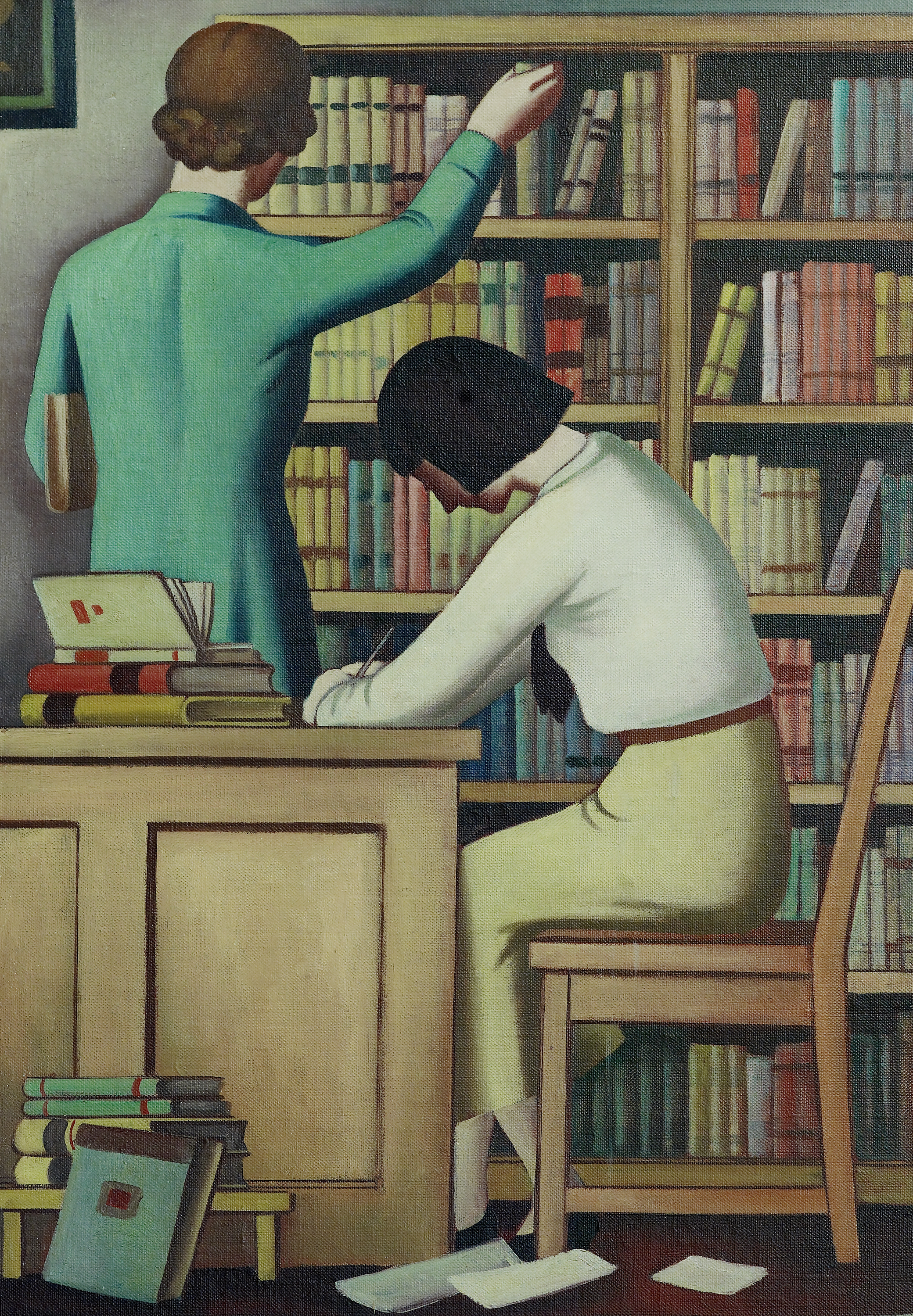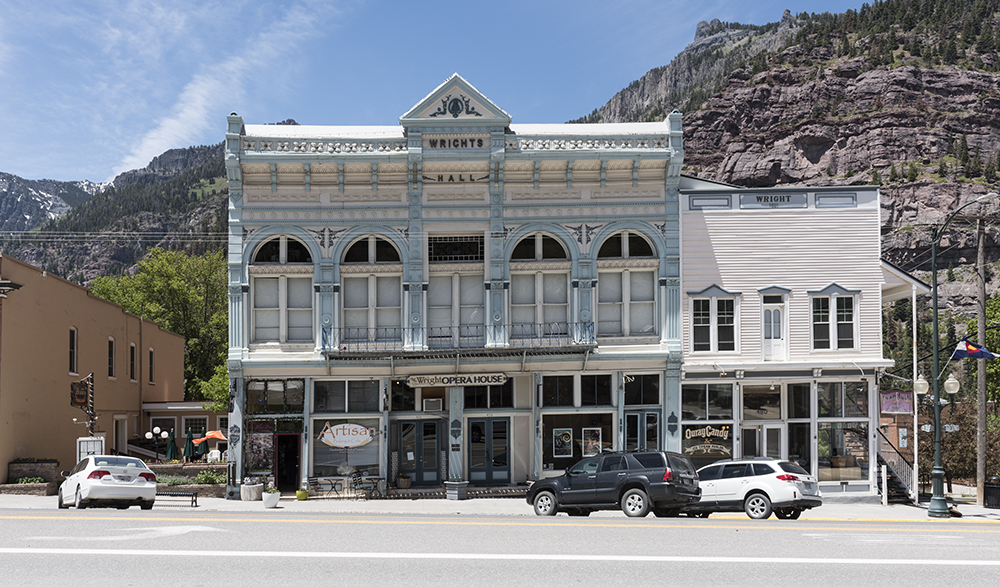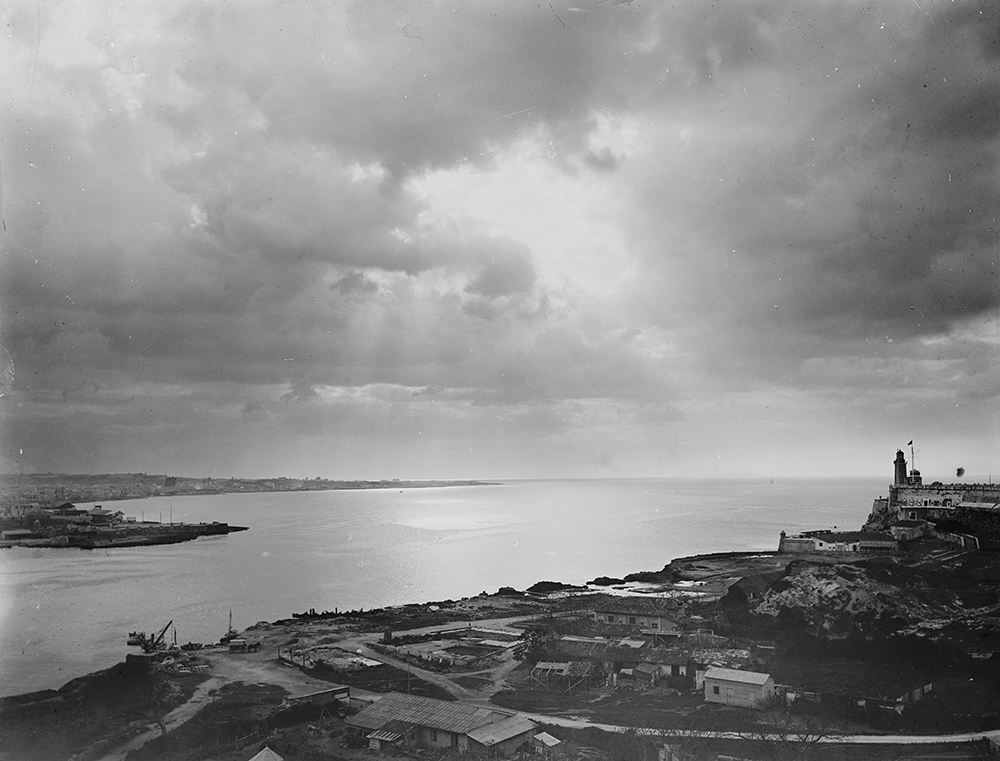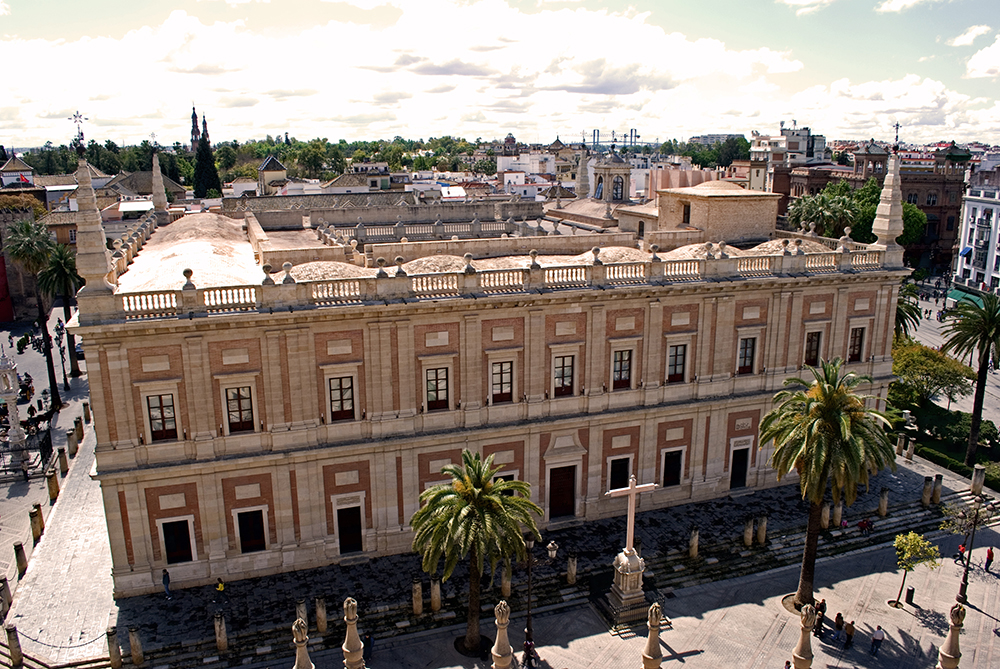
Contemporary Justice and Woman, by Emil Bisttram, 1937. Photograph by Carol M. Highsmith. Library of Congress, Prints and Photographs Division.
In April 1924, a fifty-two-page report titled “Dispatches of Spanish Officials Bearing on the Free Negro Settlement of Gracia Real de Santa Teresa de Mose, Florida” appeared in the spring issue of The Journal of Negro History. It was a detailed introduction to a forgotten eighteenth-century hamlet known as Fort Mose in St. Augustine, Florida, edited and translated into English for the first time by little-known historian and journalist Irene A. Wright. The site had been lost for nearly two hundred years. As the report’s title suggests, Fort Mose was a free black settlement, the first of its kind. Escaped slaves of British colonies in the Carolinas found freedom there in exchange for military service to the Spanish Crown. For a few short years in the mid-eighteenth century it represented the last stop on the original Underground Railroad.
Although it didn’t get much attention at the time of publication, the story of a free black settlement 125 years before emancipation eventually helped establish a new branch of colonial studies that reexamined the role of Africans in the New World. As Wright put it, the study “introduces most of our investigators to a new field of colonial history…these documents present not only as facts as to the slave trade, but records of valuable service rendered the state by Negroes as individuals and as members of military organizations.”1
The documents came from the General Archive of the Indies in Seville, Spain, where Wright found “a wealth of material” not limited to the writing of black history in the Americas and Caribbean. It extended to the earliest colonial period in the United States—that is, the colonization of Florida and the Southeast—as told through the diaries, decrees, and correspondences of Spanish, English, and Dutch imperialists. “We of the United States hardly realize how much of our own early history lies in those early reports of Spanish soldiers, traders, and priests. Their records are as much our history as they are the history of Spain,” Wright said. Sharp as her statement was, historians either did not fully grasp or decided not to amplify it until much later in the twentieth century. At that point, Irene was already gone. Her mode of research and the narratives she uncovered marked a turning point in the accumulation of colonial history, but even as a pioneer in her field, she is almost never personally credited. Contemporary historians of the Age of Exploration are indebted to her, often without even knowing it. At the General Archive of the Indies, her guiding presence is everywhere.
Irene Aloha Wright—the middle name is of unknown provenance—was born in Ouray, Colorado, a small mining town in the foothills of the San Juan Mountains, in December 1879. Her father, Ed, and uncle George, sons of Irish immigrants, had left their interim home in Ontario and followed the Gold Rush to the Western Territory. After selling an interest share in a gold mine, her father purchased a new home in Ouray. In 1888 he built an opera house downtown. The Wright Opera House, now on the National Register of Historic Places, is still in business today.

When Wright was fifteen, her father died. That same year, Wright’s mother, Letitia Wright, enrolled her in the Virginia College for Young Ladies in Roanoke, Virginia, for the purpose of acquiring some “English polish.” Instead of returning to Virginia for her second year, Wright jumped a southbound train for Mexico City with some of her late father’s gold sewn into the lining of her petticoat. “It seemed to me, definitely, that Mexico City would be a great deal more fun than Virginia,” she recalled years later. “So I just went there.”
She quickly learned Spanish and found work teaching English and translating guidebooks for the natural history museum. With her gold reserve dwindling, she took on a third job as a governess for the vice president of Mexico. She stayed in the country for three years, returning home only once she was ready to reenroll in school. She graduated from the college in Roanoke and in 1902 went on to Stanford University, where she became the second woman to serve as editor-in-chief of the college newspaper.
Wright was offered a job soon after graduation as a correspondent for an American newspaper in Havana, Cuba. She set sail for the Caribbean, this time with her mother in tow. As she approached the Havana harbor for the first time, the lighthouse of Morro Castle throwing off its “golden disk” at daybreak, she was awestruck.
I felt that we had arrived in an enchanted land; whatever disillusionment I have suffered since has not uprooted, nor ever can, the love for Havana born in me that morning, at first sight.
In Havana she wrote for dailies, first the Havana Post and then the Havana Telegraph, before buying her own publication, a weekly politics and culture magazine for American readers called The Cuban Magazine. Wright set about “representing Cuba on Cuban terms,” as Lillian Guerra, a scholar of modern Latin American and Caribbean history, puts it. She exhibited “an unusually clear-eyed, remarkably respectful view of national identity and pride,” as well as a pluckiness when speaking about the legacy of colonialism in Cuba, as in her jeer about contemporary American land companies: “Hoeing an orange tree? Yes—and shaping up a new state for the Yankee Union—that’s what he’s doing.” Her first book, Cuba, came out in 1910. It was unlike any of her later works: an intimate portrayal of the social, political, and natural life and history of Cuba, compassionate and discerning but rarely precious, with an occasionally wry postmodern vigor.

Cuba is one of the rare examples of Wright’s lively personal writing style that is still in circulation. In it she is unafraid, even as a conspicuous outsider, of ribbing Cuba’s absurdist constitution (strikingly akin, in substance and tone, to the way Joan Didion tackled Cuba’s influence on South Florida in her 1987 book Miami) and doesn’t seem to hold any dogmas or doctrines about the country. “Here logic and rational sequence are not the rule. Life runs, not like reality, but after the style of librettos and stage plays,” she writes. These inconsistencies do not militate against her love for the country; in fact, the contradictions “that exist in all details of our daily life” might be exactly what she finds so beguiling:
Under these, and a thousand other circumstances of which they are typical, one learns to hesitate to call a spade either a qualified shovel or an agricultural implement, but compromises by stating, if one must commit oneself, that at a given time and at a given place it looked to one something like an azadon.
Conversely, Wright also used these oddities to weave urgent, subtly grievous passages like this one, revisiting a beleaguered holy shrine in town of El Cobre:
Possibly some of the quaintness has gone from that odd corner of the earth, but they cannot have altered much the village itself, nor the hills surrounding it, which belched forth red soil stained brilliantly with the copper that abounds. Mines at Cobre were worked by the Spanish in the very earliest days of the colony; in their tunnels and shafts the Indians forced to labor there died miserably, making room for sturdier African slaves who took their places…Later, mines, slaves and all, were abandoned. An American mining company operates here now.
It was Wright’s interest in Cuba as a young, tenuous republic and former colonial subject of Spain that led her to the General Archive of the Indies in Seville in 1914. The renaissance structure, erstwhile home of the medieval merchants’ exchange, is at the center of the city. It adjoins the Alcázar and the immutable Seville Cathedral, where Christopher Columbus and his son Diego are buried, to form possibly the most historically important square in all of Spain. “To those not familiar with the General Archive of the Indies at Seville,” Wright wrote,
I would say that it is the Spanish government’s collection…of nearly all the papers which accumulated through centuries in offices in Spain and in America from which that government administered its overseas possessions from the era of discovery until revolution wrote finis to the record of colony after colony.
Seville and its port—accessed by Spain’s only navigable river, the Guadalquivir—represented the chokepoint of Spain’s Golden Age, the channel through which all the riches generated by its colonies across the Atlantic flowed.

The Wrights were supposed to be in Spain for only a year, but they stayed for over two decades. Abandoning earlier gratifications of journalism, Irene Wright committed herself to a higher purpose: the labor of archival research. She translated and edited over one hundred thousand colonial documents. Her own personality and narrative voice receded, swapping places with the explorers she brought to life. “Not one document concerning Cuba in one thousand that exist at Seville has been made public in any way, shape, or manner,” she wrote in the introduction to The Early History of Cuba, 1492–1586, the first book she published while in Seville, in 1916. “I believe therefore I am justified in saying that the sources for Cuban history have been heretofore unknown. Bold as this statement may seem to be I believe that it, too, is justified by the facts.” And history, she posited somewhat defensively, cannot be written without access to its documentary sources.
An anxiety radiates from her early prologues and introductions—the underlying concern of having her work second-guessed or invalidated. Seemingly aware of the fact that she did not fit the profile of the archetypal historian, she offers comprehensive accounts of her research method and source material to qualify her work and preempt criticism. As Helen Delpar noted in her book Looking South: The Evolution of Latin Americanist Scholarship in the United States, 1850–1975, “Early American historians of Latin America were nearly all white men of northern European ancestry.” The way was hard for women, “for they could not expect to win positions at major public or private institutions.” Irene Wright and to some extent her contemporary Alice Bache Gould—who trained as a mathematician but went on to lead an extensive charge to collect Spanish archival materials concerning Columbus’ first voyage—instead offered their services as a researcher who assembled and translated primary source documents into manuscripts.
Wright’s next book, Historia documentada de San Cristóbal de la Habana en el siglo XVI (Documented History of San Cristóbal de la Habana in the Sixteenth Century), was completed in 1927. News of an adept, tireless researcher at the archive spread across Europe. After the historiographies of Cuba were complete, she received research commissions from the Netherlands, Britain, and Spain to translate and edit multivolume tomes regarding those countries’ early conquests and interstate rivalries in the Americas. She translated and edited three additional volumes from the General Archive of the Indies at Spain: Spanish Documents Concerning English Voyages to the Caribbean, 1527–1568; Documents Concerning English Voyages to the Spanish Main, 1569–1580; and Further English Voyages to Spanish America, 1583–1594. Finding these documents “practically untouched,” she narrated Europe’s colonial history back to its contemporary historians. “Our debt to Miss Wright’s research and editing,” wrote James A. Williamson, former vice president of both the Hakluyt Society (Wright’s publisher) and the Historical Association in London, “is not easy to express.”
Back in Florida, the family of John B. Stetson, inventor of the cowboy hat and founder of Florida’s first law school, was looking to create a collection of papers pertaining to the settlement of Florida by Spanish conquistadors. Directed to none other than Irene Wright, the family commissioned her, working remotely from her outpost in Spain, to create what historians know today as the John Batterson Stetson Collection: over 100,000 items from the Southeast borderlands revealing, as the finding aid puts it, “the voyages of exploration, the attacks of the English and French corsairs, the development of Negro slavery, the emergence of the English presence on the Atlantic seaboard, and reports on Indian customs, languages, migrations, and populations, as well as the civil, military, and ecclesiastical development of posts and missions.” Because Florida was the first territory to be colonized by Europeans—St. Augustine is the oldest permanently occupied city in North America—the Stetson Collection provided a first look at the colonization of America. The index runs chronologically from 1518, around the time Juan Ponce de León made contact, to 1819, when Spain ceded Florida to the United States in the Adams-Onís Treaty. (The collection includes the dispatches bearing on Fort Mose.) The Stetson Collection remains the most important and frequently cited collection of papers regarding the Spanish occupation of Florida to this day outside of the archive in Seville. Today one can find the original photostats of the papers at the Research Library of the St. Augustine Historical Society because Irene Wright was the first person to bring a photocopier into the archive. Microfilms are also available at various universities and historical societies across the state.
Wright’s work would diminish after her forced removal from Spain during the Spanish Civil War. In 1936, Letitia, Irene, and Irene’s daughter Flor, whom she adopted in Spain at eight weeks old, returned to America. Irene Wright laments this “dislocation” in the introduction to her fifth and final volume collected from the archive but not without encouraging her successors: “I desire again to invite attention to the wealth of materials as yet unused which in Spanish archives await the consideration of students of English history.”
Irene spent the rest of her life in New York and Washington, DC, as an associate archivist at the National Archives and a foreign affairs adviser at the State Department. She contributed occasionally to history journals but for the most part retired as a writer. The thought of not being able to return to Cuba or Spain cast a pall; she admitted in her writings that Cuba had haunted her dreams when she was away.
The manuscripts Wright prepared over her long career as a researcher were always published under the umbrella of historical societies, governments, or individuals that had contracted her work. That’s where the capital and the reputation lay. Praise was meted out to the name on the other end of the transaction. Irene A. Wright appears on the title page under the role of translator, editor, and researcher, but her works were never indexed under her name. Even in public library catalogues throughout Florida today, a search for Irene Wright does not often yield results. The value of her work was recognized by the governments and Royal Societies of the Netherlands, England, Spain, and Cuba, however. She was decorated abroad, but at home she received prizes only from organizations explicitly dedicated to the work of women—from the World Center for Women’s Archives, the American Association of University Women, and the Society of Women Geographers—and receded into obscurity. She passed away in 1972, at the age of ninety-three. An obituary in the New York Times granted a moment of posthumous honor to her name and her accomplishments. The small newspaper clipping with her portrait flashes up briefly before one’s eyes. It’s almost startling to observe her countenance after being faceless for so long. The sensation is not unlike the contemporary “Google hands” phenomenon—those alien fingers of Google’s data-entry workers accidentally captured by the scanner and interred in the vast, windswept database of digitized books.
The few historians familiar with Wright’s work say that she was relegated to the role of ghostwriter and decidedly too self-effacing to claim attribution anyway. She also never lived in Florida, the state whose history she illustrated in granular detail, and Floridians have a pathologically derisive regard for outsiders. There is a spectral quality to the story of Irene Aloha Wright that agrees with the ghostwriter role. She spent her life illuminating the untold lives of others and the early landscape of America, a place of innumerable departed souls. In doing so she had to relinquish a part of herself—the very nature of her work slowly turning her into a ghost as well. One digs up her story now in the same manner, by going into the archives to find her living there.
“My twenty-two years in Spain convinced me that archival material surpasses any fiction interest ever written,” she wrote in correspondence from 1939.
Don’t let anyone tell you that archival material is dull. What is contained in archives is the immortal portion of those who have preceded us and research work is like interviewing those who have gone beyond. Their bodies are dust—their souls are with the Creator—but the immortal part which was their minds, remains with us in the papers of archives.
1 For more on this, see Jane Landers’ seminal book Black Society in Spanish Florida or Christina Proenza-Coles’ Lapham’s Quarterly excerpt “Freedom Seekers.”↩